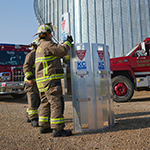Choose the right rescue tube for your operation
Identify the model that best fits your operation in the event of an emergency.
Choosing the grain rescue tube that's right for you
Grain rescue tubes serve as a cofferdam built around a victim trapped in grain. The tube is lowered into the grain surrounding the victim to enable grain removal from his immediate surroundings without continuing grain collapse.
There are a variety of grain rescue tubes available on the market today. When purchasing a rescue tube, buyers should look at the model that best fits their department. Rescue tubes and auger models change often, so it's important to consult a professional or manufacturer for recommendations on the latest equipment appropriate for your needs.
Interlocking grain rescue tubes
The Liberty Rescue System model is made of four interlocking panels made from a composite plastic and will conform to enter small openings in a grain bin. The panels are pushed into the grain using a bull driver or pull rod to drive the panels into the grain. The pull rod also gives the victim a security hand hold.
The Great Wall of Rescue was designed to adapt to a multitude of grain entrapment rescue scenarios. The lightweight wall sections are easily maneuvered and can be aligned to form a wall, a tube, or other irregular shapes depending on the rescue situation and the number of panels available. Anodized ball-and-socket joints ensure smooth panel connection, and the joint was specially designed to have some range of movement, adding to the variability in shape. Pushing the panels into the grain can be accomplished by an insertion step, pipe, or steps on the side of panels.
The Outstate Data tube is comprised of five-foot panels that are 18" wide and weigh 17 pounds. These panels can go through a 20" opening and pivot for different rescue situations. The panels are pushed into the grain via steps on the side or from the slide handle. The tube can also be used to build a wall in front of the victim if the grain is stacked in front of them.
The Grain Evacuation Tool (GET) is made up of six interlocking aluminum panels used to form ;a circle and isolate an entrapped person from the grain surrounding them.
Connecting panel tubes
The GSI Res Q tube aids in rescue during a grain engulfment if a portion of the victim is above the grain and if the grain surrounding the victim is higher than the exposed portion of the victim. GSI’s RES-Q tube is made of a lightweight aluminum for ease of transport and use.
A 60-inch tall, 27-pound shield is constructed to fit around the victim with three additional shields (30-inch diameter complete), to stop the flow of the grain toward the victim and block any additional pressure that may be created from rescuers. Once in place, the now limited amount of grain inside the tube is removed to free the victim.
Grain rescue augers complement grain rescue tubes
- Compatible with ANY grain rescue tube
- Promote a faster rescue with less stress on the victim
- Equipped for a flow rate of 1.5 bushels per minute
- Powered by a half-inch cordless, brushless drill, cord drill, or air drill.
Also consider this equipment from your fire equipment sales company
- Brushless cordless drill
- NFPA 1983 Class III Harness (1 for each crew member, entry team (min 2) and rapid intervention crew (min 2).
- Ropes (to the top of your largest bin, down the inside to the floor and across the bin. One rope for each rescuer (min 4), one for the trapped individual and 2 (min) for utility)
- Carabineers
- Patient rescue harness (or minimum webbing to make one)
- Helmets (min one for patient)
- Pop crates or commercial platform
- Rope protectors
- Anchor equipment (optional if technical rescue is nearby)
- Hearing protection
- Metal saw
Some rescue departments will already have some of this equipment on hand, however if you have a rope rescue team nearby, you may choose to utilize them as a mutual aid partner.
The National Education Center for Agricultural Safety (NECAS) and Nationwide do not recommend or endorse products. Buyers must consider several factors in their evaluation of equipment to fit their needs. Consult a professional for advice. Use of a rescue tube requires proper training and equipment. Always follow federal, state and local fire codes and worker safety requirements.

 >
>

 >
>
 >
>